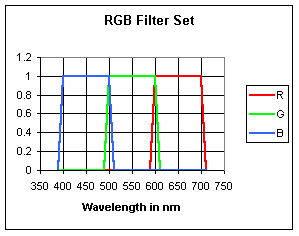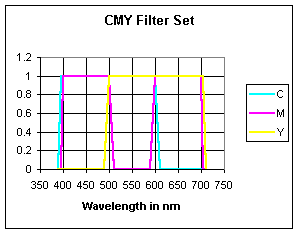 |
Figure One: RGB Filters |
The Fictitious CMY Filter Advantage
Alan Holmes
President, SBIG
Date: 01/02/01
Much has been reported in the popular media about the superiority of CMY filters over RGB. The discussion makes me grit my teeth in frustration, since CMY filters are a mistake for astronomical purposes. They work fine for baby pictures with cheap digital cameras, but not for quality or scientific work. In this note I explain my controversial viewpoint.
CMY filters have three major problems. I will discuss each in turn. Either one of these problems is a showstopper for astronomical work, as far as I am concerned.
Problem One - CMY filters degrade the image signal to noise ratio (SNR)
This is easily illustrated with an example. Figures One and Two illustrate some hypothetical RGB and CMY filters.
 |
Figure One: RGB Filters |
 |
Figure Two: CMY Filters |
Note that the signal in each of the CMY filters can be found from the RGB signals following simple equations.
C = B + G
M = R + B
Y = R + G
Lets say we take an image of a galaxy with the RGB filter set, one minute per filter, and I find that each filtered image has 1000 electrons of signal in a spiral arm. The "shot" noise due to this signal is the square root of the number of electrons, or 31.6 electrons rms (root mean square). If my CCD has a read noise level of 10 electrons, the total noise in each dark subtracted image is:
Noise = Square root ( 31.6^2 + 2*(10^2)) = 34.64 electrons rms
The signal to noise in my blue image is then the ratio of the signal to the rms noise, or:
SNR = 1000/34.64 = 28.87
Now let us find the signal to noise in a blue image derived from CMY images taken using the same exposure. I have to find a blue image since all computer monitors are RGB – I have to give each pixel a red, green, or blue value. Using my earlier simple equations I find that each filter will now give me a total of 2000 electrons of signal in the spiral arm. But what is the noise? The shot noise in each image is the square root of 2000, or 44.72 electrons rms. The total noise in each image is therefore:
Noise = Square root(44.72^2 + 2*(10^2)) = 46.90 electrons rms
The signal to noise ratio in each image (C, M, or Y) is:
SNR = 2000/46.90 = 42.64
Note that the SNR in this image is 1.5X better than for a blue filtered image. This is why people think they are getting better results. The intermediate C, M, or Y image is better than an equal R, G or B image. But, we’re not done! I have to derive a blue value for each pixel. One can manipulate the above equations to find that the blue data is given by:
Blue signal = M – Y + C
=2000-2000+ 2000 = 2000 electrons
So, I have twice the blue signal as I got using a blue filter. But, what is the noise? Noise adds in an rms sense.
Noise = square root (46.9^2 + 46.9^2 + 46.9^2) = 81.2 electrons rms
My signal to noise ratio for the blue data is now:
SNR = 2000/81.2 = 24.6
This is 15% poorer than for an exposure using a blue filter. What went wrong? Look at the equations above. With the magenta filter, for example, the shot noise due to the red light striking the CCD corrupts the blue data. When I want to derive the blue signal, I have to use the Y image data, which contains no blue signal at all – its just red and green, but it does add noise! This clearly illustrates that images taken using CMY filters will have poorer SNR that images taken using RGB filters.
Problem Two – CMY filters do not allow correction of atmospheric refraction, increasing blur.
We all know that the atmosphere, at low elevation angles, acts like a prism displacing the red and blue images of a star or planet slightly from each other. Look at the implications of this if you are using a magenta filter, which passes red and blue simultaneously. You get some smear due to the prismatic effect in the direction of the vertical. The C and Y filters have the same problem to a lesser degree. The effect occurs with RGB, of course, except that you can correct for it by slightly shifting the blue image relative to the red when doing the color merge. This effect is not ignorable. At 45 degrees elevation you will get 2 arcseconds of smear, and at 60 degrees elevation it is still 1 arcsecond. This is not a problem if you are imaging something straight up, but for most of us mid-latitude dwellers, that’s not always possible, particularly on Milky Way objects in Sagittarius. By the way, this problem imposes a resolution limit on unfiltered CCD imaging, and also occurs with film. Fortunately, RGB imaging minimizes it. You want more blur? – use CMY!
Problem Three – CMY images are completely uncalibratable
My simple equations of the first section glossed over a huge problem with CMY. Real filters do not have sharply defined passbands that have rising and falling edges exactly coincident. What if, unbeknownest to me, my Magenta filter has a little too much red, and is actually equivalent to:
M = B + 1.1R
How does this affect the ratio of blue to red, which I might use to calculate the color temperature of the galaxy arm, or balance a color image? I will spare everyone the math, but the blue to red ratio, which would have been 1:1 with the RGB filter set, is erroneously found to be 0.955:1, a 4.5 % error. Five percent of the derived blue signal is actually red light. Doesn’t sound too bad? What if the blue signal in that portion of the galaxy was only 100 electrons? Then, instead of finding a ratio of 0.100 blue to red, you would find 0.136, a 36 percent error. A red leak makes the images too blue. Longer exposures will not make this error better, either. CMY is useless for scientific work.
In summary, I find no advantage for CMY filter sets, and I find three BIG disadvantages – decreased sensitivity, increased blur, and color errors. Save CMY for baby pictures! I hope I’m not understating my opinion.
- Alan Holmes
Revised: January 02, 2001 09:52:28 AM.
Copyright © 2001 Santa Barbara Instrument Group, Inc. All rights reserved.
Please report any problems with this page directly to the Webmaster